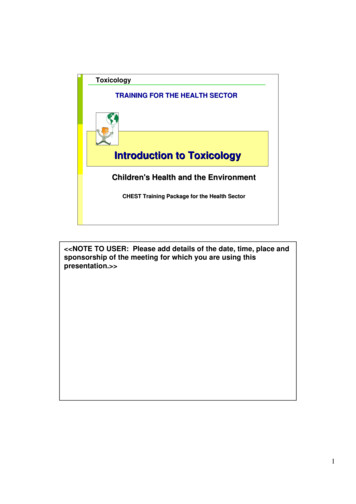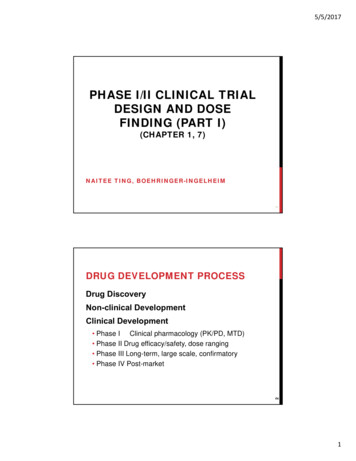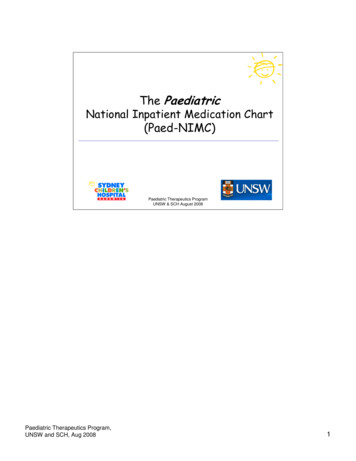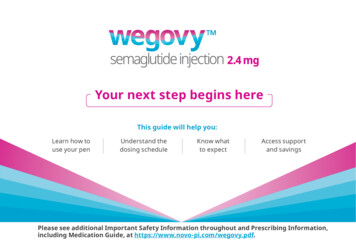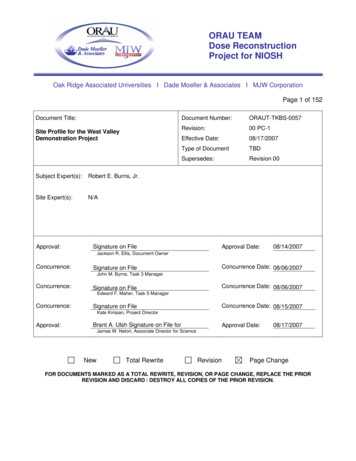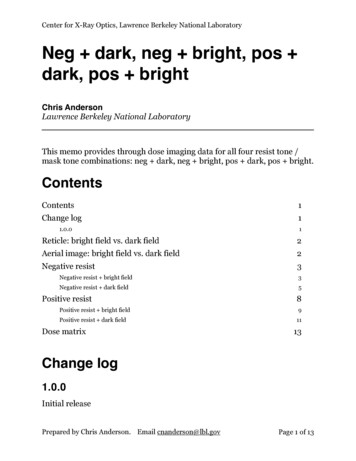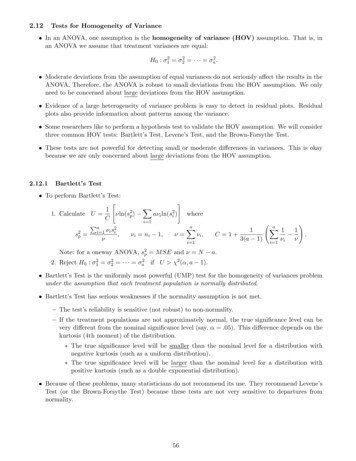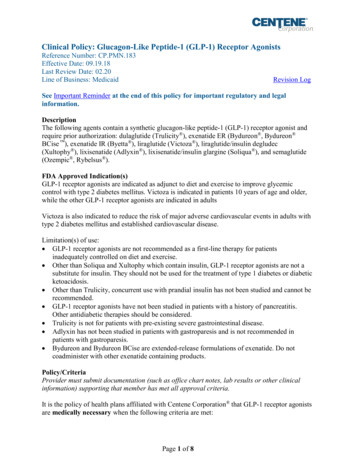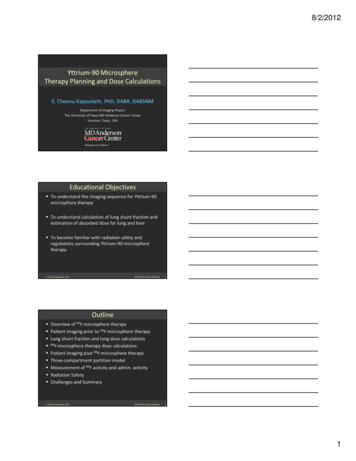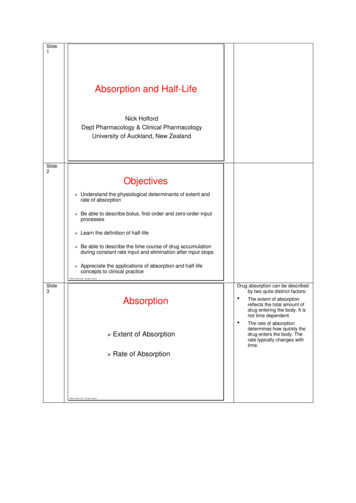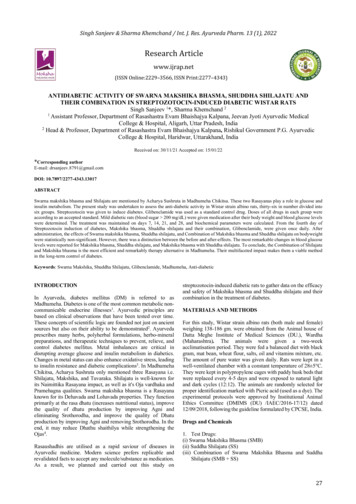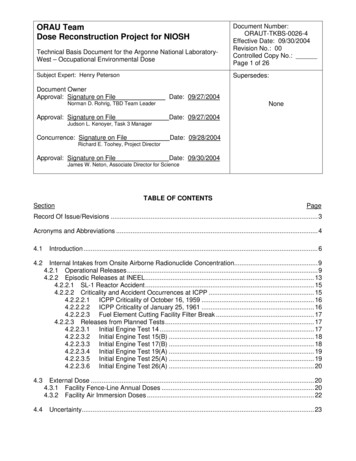
Transcription
ORAU TeamDose Reconstruction Project for NIOSHTechnical Basis Document for the Argonne National LaboratoryWest – Occupational Environmental DoseSubject Expert: Henry PetersonDocument Number:ORAUT-TKBS-0026-4Effective Date: 09/30/2004Revision No.: 00Controlled Copy No.:Page 1 of 26Supersedes:Document OwnerApproval: Signature on FileDate: 09/27/2004NoneNorman D. Rohrig, TBD Team LeaderApproval: Signature on FileDate: 09/27/2004Judson L. Kenoyer, Task 3 ManagerConcurrence: Signature on FileDate: 09/28/2004Richard E. Toohey, Project DirectorApproval: Signature on FileDate: 09/30/2004James W. Neton, Associate Director for ScienceTABLE OF CONTENTSSectionPageRecord Of Issue/Revisions . 3Acronyms and Abbreviations . 44.1Introduction . 64.2Internal Intakes from Onsite Airborne Radionuclide Concentration. 94.2.1 Operational Releases . 94.2.2 Episodic Releases at INEEL . 134.2.2.1 SL-1 Reactor Accident . 154.2.2.2 Criticality and Accident Occurrences at ICPP . 154.2.2.2.1 ICPP Criticality of October 16, 1959 . 164.2.2.2.2 ICPP Criticality of January 25, 1961 . 164.2.2.2.3 Fuel Element Cutting Facility Filter Break . 174.2.2.3 Releases from Planned Tests . 174.2.2.3.1 Initial Engine Test 14 . 174.2.2.3.2 Initial Engine Test 15(B) . 184.2.2.3.3 Initial Engine Test 17(B) . 184.2.2.3.4 Initial Engine Test 19(A) . 194.2.2.3.5 Initial Engine Test 25(A) . 194.2.2.3.6 Initial Engine Test 26(A) . 204.3External Dose . 204.3.1 Facility Fence-Line Annual Doses . 204.3.2 Facility Air Immersion Doses . 224.4Uncertainty. 23
Effective Date: 09/30/2004Revision No. 00Document No. ORAUT-TKBS-0026-4Page 2 of 26References . 24LIST OF TABLESTablePage4-1 Intake by year for ANL, 1952-2002 . 114-2 Comparison of calculated facility intakes with intakes from environmentalmonitoring results . 124-3 Intakes at EBR-I for criticalities at ICPP . 164-4 Intakes at EBR-I for FECF filter break incident at ICPP . 174-5 Intakes at EBR-I for Initial Engine Tests at INEEL . 184-6 INEEL facility fence direct gamma values (TLD – background) mR). 22LIST OF FIGURESFigurePage4-1INEEL site map . 74-2Nine-year (1974 - 1983) average mesoscale dispersion isopleths of airconcentration at ground level (hr2/m3 x 10-9), normalized to unit release rate . 104-3Onsite and distant particulate beta concentrations in air . 144-4Dispersion coefficient contours for SL-1 accident . 154-5Example of onsite TLD Monitoring Data . 21
Effective Date: 09/30/2004Revision No. 00Document No. ORAUT-TKBS-0026-4Page 3 of 26RECORD OF /200409/30/200400DESCRIPTIONNew Technical Basis Document for the ArgonneNational Laboratory – OccupationalEnvironmental Dose. Initiated by Norman D.Rohrig.Incorporates NIOSH and internal reviewcomments. Initiated by Norman D. Rohrig.First approved issue. Initiated by Norman D.Rohrig.
Effective Date: 09/30/2004Revision No. 00Document No. ORAUT-TKBS-0026-4ACRONYMS AND ABBREVIATIONSAECAFSRANL-WARAATRU.S. Atomic Energy CommissionArgonne Fast Source ReactorArgonne National Laboratory-WestAuxiliary Reactor AreaAdvanced Test ReactorBORAXBqBoiling Water Reactor ExperimentBecquerel (1 disintegration per second)CDCCERTCFACFRCiCPPCenters for Disease Control and PreventionControlled Environmental Release TestCentral Facilities AreaCode of Federal Regulationscurie(Idaho) Chemical Processing PlantDOEU.S. Department of EnergyEBR-IEBR-IIEFSEMDREMRETRExperimental Breeder Reactor No. 1Experimental Breeder Reactor No. 2Experimental Field StationEnvironmental Monitoring Data ReportEnvironmental Monitoring ReportEngineering Test ReactorFfCiFECFFPFPFRTFast (solubility rate)femtocurieFuel Element Cutting FacilityFission ProductFission Product Field Release TestGEGE-ANPGeneral Electric (Company)General Electric-Advanced Nuclear Propulsion (Program)H&SHTREHealth & Safety (management organization)Heat Transfer Reactor ExperimentICPPIDO, IDIETINEELINELINELHDEINTECIdaho Chemical Processing PlantIdaho Operations Office (of AEC)Initial Engine TestIdaho National Engineering and Environmental LaboratoryIdaho National Engineering LaboratoryIdaho National Engineering Laboratory Historical Dose EvaluationIdaho Nuclear Technology and Engineering CenterkWkilowattMmRModerate (solubility rate)milliRoentgenPage 4 of 26
Effective Date: 09/30/2004Revision No. 00Document No. ORAUT-TKBS-0026-4mremMTRmilliremMaterials Testing ReactorNCRPNOAANRTSNational Council on Radiation Protection and MeasurementsNational Oceanic and Atmospheric AdministrationNational Reactor Testing StationRACRMRSACRWMCRadiological Assessment Corporationradioactive materialRadiological Safety Analysis Computer (program)Radioactive Waste Management ComplexSSL-1Slow (solubility rate)Stationary Low-Power Reactor No. 1TANTBDTLDTRATREATTest Area Northtechnical basis documentthermoluminescent dosimeterTest Reactor AreaTransient Reactor TestU.S.C.United States CodeZPRZPPRZero Power ReactorZero Power Plutonium ReactorPage 5 of 26
Effective Date: 09/30/20044.1Revision No. 00Document No. ORAUT-TKBS-0026-4Page 6 of 26INTRODUCTIONTechnical Basis Documents (TBDs) and Site Profile Documents are general working documents thatprovide guidance concerning the preparation of dose reconstructions at particular sites or categoriesof sites. They will be revised in the event additional relevant information is obtained about theaffected site(s). These documents may be used to assist the National Institute for OccupationalSafety and Health in the completion of the individual work required for each dose reconstruction.In this document the word “facility” is used as a general term for an area, building, or group ofbuildings that served a specific purpose at a site. It does not necessarily connote an “atomic weaponsemployer facility” or a “Department of Energy facility” as defined in the Energy EmployeeOccupational Illness Compensation Program Act of 2000 (42 U.S.C. § 7384l (5) and (12)).This TBD addresses radioactive material (RM) releases from areas or facilities at the Idaho NationalEngineering and Environmental Laboratory (INEEL), formerly the National Reactor Testing Station(NRTS) and later the Idaho National Engineering Laboratory (INEL), that could affect employees atthe Argonne National Laboratory-West (ANL-W) facility. The analysis for this TBD divided releasesinto two components: (1) normal “chronic” operational releases, and (2) episodic releases thatgenerally are of short duration. These releases potentially represent unrecorded or missed doses, aseither direct gamma radiation or beta-gamma radiation from immersion in the radioactive gaseouscloud, for individuals who did not have personal dosimetry to record the dose, or as internal dosesfrom RM inhalation.In addition, this TBD addresses direct gamma doses resulting from facility operations. In general,these doses, if not controlled by management, increase with time and create a facility backgrounddose. At INEEL, these facility background doses were recorded by film badges infrequently andinconsistently before 1970 and by thermoluminescent dosimeters (TLDs) on a routine basis since1972. These facility background doses, or facility fence-line doses, as they are sometimes called, area nebulous indication of a dose that workers could receive if they inhabited outside areas within thefacility. This TBD presents ANL-W facility fence-line doses (minus background) for three locations: 1)the EBR-I location for 1952 to 1972, 2) the Transient Reactor Test (TREAT) facility and theExperimental Breeder Reactor (EBR)-II both for 1972 to present.As outlined and discussed in Part 2 of the ANL-W facility profile (ORAU 2004), the U.S. AtomicEnergy Commission (AEC) selected the INEEL Site as an isolated location for testing various reactorconcepts. The INEEL is isolated from the public in two important aspects: (1) it is remote frompopulation centers, and (2) it is isolated hydrologically because no surface streams originate on theSite and flow to an offsite location and no streams cross the Site. Although the INEEL sits above thelarge Snake River Aquifer that eventually surfaces and enters the Snake River in the HagermanValley area, the annual flow rate of the water in the aquifer is 5 to 15 feet per day.ANL-W is a unique facility at the INEEL. Although inside the INEEL boundary, ANL-W is under thejurisdiction of the U.S. Department of Energy (DOE) Chicago Operations Office. Although the facilityoperates in accordance with 10 CFR 835, its operations have been and are more in line with auniversity atmosphere engaged with pure nuclear energy research; these operations support those ofthe University of Chicago or ANL-E, near Chicago, Illinois. During its first 14 years of operation (i.e.,from 1951 through 1965), ANL-W was in the southwest corner of INEEL at the location of EBR-I. Atthis location ANL-W conducted EBR-I, Zero Power Reactor No. 3 (ZPR-III), Argonne Fast SourceReactor (AFSR), and all Boiling Water Reactor Experiments (BORAX) tests. In 1958, constructionbegan on the TREAT Facility and on the EBR-II at the location presently designated as ANL-W at the
Effective Date: 09/30/2004Revision No. 00Document No. ORAUT-TKBS-0026-4Page 7 of 26southeastern corner of INEEL. Since the mid-1970s, essentially all ANL-W operations have beenconducted at the present ANL-W location, as shown on Figure 4-1.RENO RANCH SOUTHSECURITY GATE CERRO GRANDEFRENCHMAN’SCABIN Figure 4-1. INEEL site map.During the 50-year history of the INEEL Site, DOE and its predecessor agencies designed, built, andoperated about 50 different reactor concepts at INEEL. All of these reactors have been prototype,low-power critical, or test reactors. INEEL operated no weapons production or commercial powerreactors. Most, if not all, of these reactors have used highly enriched (93% or higher) uranium as fuel.Only a few have produced significant airborne effluent: (1) the Heat Transfer Reactor Experiment(HTRE) reactors, operated under the General Electric-Aircraft Nuclear Propulsion (GE-ANP) Programat the north end of the INEEL Site at Test Area North (TAN), (2) test reactors [Materials TestingReactor (MTR), Engineering Test Reactor (ETR), and Advanced Test Reactor (ATR)], all at the TestReactor Area (TRA) near the middle southern end of the Site, and (3) EBR-II at ANL-W at thesoutheastern corner of the Site, which has produced minor amounts of airborne effluent.Another historically important airborne effluent producer is the Idaho Nuclear Technology andEngineering Center (INTEC), formerly known as the Idaho Chemical Processing Plant (ICPP). Thisfacility, constructed in the early 1950s, began processing nuclear fuel in February 1953 and continued
Effective Date: 09/30/2004Revision No. 00Document No. ORAUT-TKBS-0026-4Page 8 of 26until 1992. Throughout its history, the “Chem” Plant, as it is commonly known, has reprocessed fuelfrom test reactors at INEEL, zirconium-clad fuel reclaimed from various reactors, stainless-clad fuelfrom EBR-II, and many AEC test reactors from around the world. Apart from the GE-ANP Program,which tested nuclear powered aircraft engine concepts with only one barrier (fuel cladding) betweenthe fission products and the environment, TRA and ICPP airborne releases have been the mostradiologically significant releases at INEEL (RAC 2002). Through the years that INEEL has publishedenvironmental monitoring reports, ICPP airborne effluents have been attributed to creating themajority of the INEEL “boundary dose.” Considering this fact, dose reconstructors should suspectICPP airborne effluent as responsible for the maximum INEEL worker doses. Calculations performedfor the INEEL TBD show that although ICPP airborne effluent is the most radiologically significantrelease at INEEL, the impact to all facility workers at INEEL is significantly below the allowable andacceptable limit. Figure 4-1 shows INEEL facility locations, including the EBR-I and ANL-W facilities.From the beginning of operations at the INEEL Site, DOE and its predecessor agencies selectedfacility locations to limit the potential for operational releases at one facility to affect another facility.Because the Site encompasses 890 square miles, there was ample room to place facilities with thisprinciple in mind. Because the Site has an average elevation of 5,000 feet and its generalmeteorological characterization indicates a nocturnal inversion from the north-northeast and a daytimelapse condition with winds from the southwest, transitional weather regimes are less frequent than atlower elevations. The 50-year history of the Site has demonstrated that the large expanse of INEELand this meteorological characteristic have been effective in maintaining the operational isolation ofeach facility.Beginning with the GE-ANP program, which began in the early 1950s, the INEEL Site has had thecapability of plume tracking by aircraft. The local National Oceanic and Atmospheric Administration(NOAA) field office, which was dedicated to INEEL needs and requirements, provided plumeprojection capabilities for various programs with a rather extensive network of meteorologicalmonitoring stations (Yanskey, Markee, and Richter 1966). The plumes from all intentional plannedreleases from the GE-ANP tests, the Controlled Environmental Release Test (CERT), the FissionProduct Field Release Test (FPFRT), the Fuel Element Burn Tests A and B, etc., were directed overan instrumented monitoring grid (GRID III) that was remote from other facilities, such that releases didnot affect other onsite facilities.INEEL reviewed and analyzed all airborne releases that have occurred since the beginning of Siteoperations as a result of a request from the DOE Idaho Operations Office (IDO) to evaluate theradiological impact to individuals at the INEEL boundary from airborne releases that had occurredsince the beginning of Site operations. With the help of NOAA, which had hourly meteorological datafrom 1956 to that time, INEEL completed analyses for all airborne releases that occurred at the Site.Radiological consequences for an adult, a child, and an infant were calculated with Version 4 of theRadiological Safety Analysis Computer program RSAC-4 (Wenzel 1990). The results of the studywere published in the Idaho National Engineering Laboratory Historical Dose Evaluation (DOE 1991);this TBD refers to that report as the INELHDE. All releases considered for that report are the basesfor the releases considered in this TBD. In addition, all releases documented in the INELHDE,operational and episodic, have been independently reviewed and found, with minor modifications, tobe substantially appropriate. The review, conducted by Radiological Assessment Corporation (RAC2002) at the request of the Centers for Disease Control and Prevention (CDC) and the State of Idaho,evaluated the methodology by which the RSAC-4 computer program performs dose calculationsagainst the methodology favored by the National Council on Radiological Protection andMeasurements (NCRP). It stated: “As a final point, Tables 7, 8, 9a, 9b, 10a, and 10b, and Figures 18and 19 confirm that the NCRP method was suitable for these ranking purposes when the results are
Effective Date: 09/30/2004Revision No. 00Document No. ORAUT-TKBS-0026-4Page 9 of 26compared with those using the RSAC code. In all cases, the RSAC code confirmed the resultsobtained using the NCRP methodology” (RAC 2002, p. 57).Version 6 of the RSAC code (Wenzel and Schrader 2001) is used extensively in this document toprovide onsite concentrations due to episodic releases as well as other evaluations. For moreinformation on the RSAC code, see Peterson (2004).EBR-I was the first reactor to operate at the Site. It and BORAX-I through –V were in thesouthwestern corner of INEEL, operated under the AEC Chicago Operations Office by the Universityof Chicago as ANL-W. These low-power reactors produced essentially no radioactive airborneeffluent. As the EBR-I and BORAX programs ended, ANL-W relocated the locations of EBR-II, theTREAT Facility, the Zero Power Plutonium Reactor (ZPPR), etc., to the eastern section of INEEL.The EBR-I location is now a historic landmark and is open to the public during the summer months.All inhaled quantities and concentrations referred to in this TBD apply to individuals stationed at theANL-W facility, at the South-West location through 1965, and at the South-East location beginning in1966.4.2INTERNAL INTAKES FROM ONSITE AIRBORNE RADIONUCLIDE CONCENTRATIONThis section addresses onsite concentrations of radionuclides and onsite internal personnel intakesfrom normal operational releases and from shorter term releases such as those from criticalityincidents at ICPP and tests performed by the GE-ANP Program at TAN. As stated above, operationalreleases from ICPP and TRA have been the predominant and radiologically significant releases atINEEL during the history of the Site. For more discussion of these releases and their relationship toother, less significant releases, see Peterson (2004), DOE (1991), or RAC 2002.For worker dose reconstruction, the analyst should use default values for the calculation underconsideration. When solubility is of concern, an insoluble oxide form for solids is recommended foranalysis, with “S” and “M” type materials being the predominant form. Without more definitiveinformation on the type of material, the dose reconstructor should use the material that maximizes thedose for a particular situation. When iodines are of concern, the dose reconstructor should considerthem to be “F” type materials.4.2.1Operational ReleasesEstimation of onsite concentrations of radionuclides and resulting potential intakes from operationalreleases at INEEL facility locations employs the same methodology used to determine offsiteconcentrations for Site annual environmental monitoring reports. The release for each year ofoperation is exactly the same as that documented in INELHDE (DOE 1991) with one exception: ananalysis to reduce the number of radionuclides and yet retain those that contributed about 95% of theinhalation dose (see Peterson 2004) reduced the number of radionuclides from 56 to 9 for theoperational releases.Meteorological dispersion factors applicable to each INEEL facility were picked from the annualaverage mesoscale dispersion isopleths of ground-level air concentrations as published inenvironmental monitoring reports, as described in INELHDE (DOE 1991). As described in AppendixB of that document, dispersion isopleths are available for years beginning in 1973, with the exceptionof 1978, when INEEL upgraded the telemetry system. For years prior to 1973, the TBD analysis useda 9-year average of mesoscale dispersion isopleths of ground-level air concentrations (Bowman
Effective Date: 09/30/2004Revision No. 00Document No. ORAUT-TKBS-0026-4Page 10 of 261984), shown in Figure 4-2. For 1993 to 2002, the analysis used annual average mesoscale isoplethsfrom the annual environmental reports (ESRF 1994, 1995, 1996, 1997, 1998, 2000; Stoller 2002a,b,c)to calculate the facility annual concentration.Of the many facilities on INEEL, this analysis considered only the ANL-W facility. Yearly isoplethvalues for each ANL-W location (EBR-I for 1952 to 1965 and EBR-II for 1966 to present) have beenextracted from the annual environmental monitoring reports and converted from the normalizedannual concentration 1 (hr2/m3) to concentrations (Bq/m3)Figure 4-2. Nine-year (1974 - 1983) average mesoscale dispersion isoplethsof air concentration at ground level (hr2/m3 x 10-9), normalized to unit releaserate (Bowman 1984).and multiplied by 2.4 103 m3/yr (the amount of air breathed occupationally per year) to produceactivity inhaled per year (Bq) for an occupational individual. Table 4-1 lists these values.The annual inhaled quantities (Bq/yr) listed in Table 4-1 are based on known and published INEELannual airborne emissions. The following discussion provides information that is located inNRTS/INEL/INEEL documentation on facility environmental sampling/monitoring and data that can becompared with the calculated inhaled quantities of Table 4-1. “Environmental” air sampling at thefacility areas has been performed at least since the mid-1950s where airborne effluents were knownor suspected to exist. The early IDO Health and Safety (H&S) Division Annual Reports documentmany studies for defining radionuclide concentrations in the vicinity of different facilities. These1As used at the INEEL, this quantity is the sum of 8,766 calculations of the hourly average χ/Q.
Effective Date: 09/30/2004Revision No. 00Document No. ORAUT-TKBS-0026-4Page 11 of 26Table 4-1. Intake (Bq yr-1) by year for ANL-W, 719981999200020012002Ce-1442.4E 12.4E 16.0E 18.3E 19.6E 11.9E 12.6E 12.1E 12.8E-12.0E-18.9E-11.4E 17.8E 02.0E 12.8E 07.0E-25.0E 02.8E-16.6E-12.5E E-42.9E-41.2E-41.2E-41.2E-40.0E 00.0E 00.0E 00.0E 00.0E 00.0E 00.0E 00.0E 00.0E 00.0E 0I-1311.4E-13.1E-12.3E-13.4E-14.0E 04.8E 23.6E 27.8E 11.1E 11.5E 11.4E 19.2E 04.8E-13.2E 51.6E-51.8E-53.8E-63.1E-52.1E-52.8E-50.0E 02.3E-53.1E-51.9E-31.0E-31.6E-4Pm-1470.0E 05.7E 01.4E 12.0E 12.3E 14.8E 16.9E 15.7E 16.0E-11.4E-22.0E 04.0E 10.0E 00.0E 00.0E 00.0E 00.0E 00.0E 00.0E 00.0E 00.0E 00.0E 00.0E 00.0E 00.0E 00.0E 00.0E 00.0E 00.0E 00.0E 00.0E 00.0E 00.0E 00.0E 00.0E 00.0E 00.0E 00.0E 00.0E 00.0E 00.0E 00.0E 00.0E 00.0E 00.0E 00.0E 00.0E 00.0E 00.0E 00.0E 00.0E 0Pu-2380.0E .3E-61.4E-61.1E-65.7E-99.4E-101.0E-101.7E-70.0E 00.0E u-239, 2400.0E .8E-5Ru-1061.7E 01.7E 04.4E 06.1E 07.0E 02.0E 02.8E 02.3E 02.8E-21.2E-28.9E-21.6E 01.2E 28.5E 01.2E 11.7E 07.4E-13.7E-13.0E-13.2E E-21.6E-44.2E-55.2E-51.4E-53.5E-50.0E 00.0E 00.0E 00.0E 00.0E 00.0E 00.0E 00.0E 00.0E 0Sr-890.0E 01.7E 04.3E 06.0E 07.2E 06.6E 05.1E 02.6E 03.2E-18.5E-18.6E-15.4E-11.3E-10.0E 00.0E 00.0E 00.0E 00.0E 00.0E 00.0E 00.0E 00.0E 00.0E 00.0E 00.0E 00.0E 00.0E 00.0E 00.0E 00.0E 00.0E 00.0E 00.0E 00.0E 00.0E 00.0E 00.0E 00.0E 00.0E 00.0E 00.0E 00.0E 00.0E 00.0E 00.0E 00.0E 00.0E 00.0E 00.0E 00.0E 00.0E 0Sr-905.4E-12.9E 05.1E 07.3E 07.6E 01.2E 11.8E 11.5E 19.0E-11.1E 01.6E 01.2E 13.0E 01.2E 17.8E-12.1E-11.2E 03.6E-12.7E-11.1E 62.4E-51.1E-54.4E-63.5E-31.2E-43.8E-3Y-912.2E 03.7E 09.2E 01.3E 11.5E 17.3E 05.6E 02.9E 03.5E-19.2E-19.3E-16.0E-18.5E 07.5E 01.2E 23.1E-20.0E 00.0E 00.0E 00.0E 00.0E 00.0E 00.0E 00.0E 00.0E 00.0E 0
Effective Date: 09/30/2004Revision No. 00Document No. ORAUT-TKBS-0026-4Page 12 of 26studies were specific for a given test, operation, or incident, however, and did not occur in a setlocation or for a standard duration. The 1963 Annual Progress Report of the IDO Health and SafetyDivision (AEC no date) contains some facility environmental monitoring data. INEEL developed aroutine facility environmental monitoring program between 1963 and 1970. In 1968 and 1969, formalEnvironmental Monitoring Reports (EMRs) (AEC ‘1968’, AEC ‘1969’) reported alpha, beta, and I-131concentrations that can be correlated with the data of Table 4-1. The 1970 EMR (AEC ‘1970’) reportsgross beta values measured at the Central Facilities Area (CFA) that can be correlated with Table 4-1(EBR-I) values. The analysis for this TBD reviewed EMRs between 1970 and 1990 for data that isavailable and usable for this correlation.Table 4-2 lists results of the comparison. Because of the large variation in measurements made, theratio of values calculated from the EMRs (column 4) to that derived from releases shown in Table 4-1is not well behaved (geometric mean of 0.39 and geometric standard deviation of 5.6). Neverthelessthis comparison provides confidence in the results of Table 4-1. The deviation of the average ratiofrom 1 is small compared to the default geometric standard deviation of 3 assumed for environmentalresults.Table 4-2. Comparison of calculated facility intakes with intakes from environmentalmonitoring results a.b.c.d.e.Activity typeβ-γPu-239αβI-131αβI-131Gross βMax. gr. Β @ CFAGross 37Gross βKr-85 @ CFAKr-85 @ CFAKr-85 @ CFAAverage annualConcentration1.7E-11 μCi/cc6.0E-16 μCi/cc30.0022 pCi/m30.64 pCi/m3 0.08 pCi/m30.023 pCi/m32.95 pCi/m30.123 pCi/m6.0E-13 μCi/ml8.1E-13 μCi/ml395 42 fCi/m33.4 fCi/m31.0 fCi/m37-17 fCi/m34-8 fCi/m35.9 fCi/m30.9-2.4 fCi/m36-9.8 fCi/m30.8-1.6 fCi/m317-27 fCi/m3-6E-14 μCi/ml3.7E-11 μCi/ml1.1E-10 μCi/ml2.7E-11 μCi/mlAnnual inhaledquantity (Bq)15100.050.1856 ble 4 inhaledquantity 000e690Values from INEEL TBD Table 4-3 for CFA.Values from INEEL TBD Table 4-5 for RWMC since EBR-I is near RWMC.Of 90 monthly values (January through September) for 10 facility areas, 89 values were between-14-143 10 and 6 10 μCi/ml.Using the current tables with 11 radionuclides, the inhaled quantity is about 0.6 Bq; with theoriginal tables with 44 radionuclides, the inhaled quantity is about 25 Bq.Values derived from tables in an earlier version of the TBD report that contained concentrationsof all INEEL released radionuclides.
Effective Date: 09/30/2004Revision No. 00Document No. ORAUT-TKBS-0026-4Page 13 of 26Figure 4-3 shows the variation of INEEL Environmental Monitoring sampling results for the periodfrom 1978 through 1986 which is typical for earlier years as well as for later years. This figure alsoshows the close correlation of environmental sample results acquired at “distant communities” andthose acquired at INEEL facilities and the effect of foreign nuclear tests and the Chernobyl reactoraccident on INEEL environmental sampling results. As
Experimental Breeder Reactor (EBR)-II both for 1972 to present. As outlined and discussed in Part 2 of the ANLW facility profile (ORAU 2004), the U.S. Atomic - Energy Commission (AEC) selected the INEEL Site as an isolated location for testing various reactor
